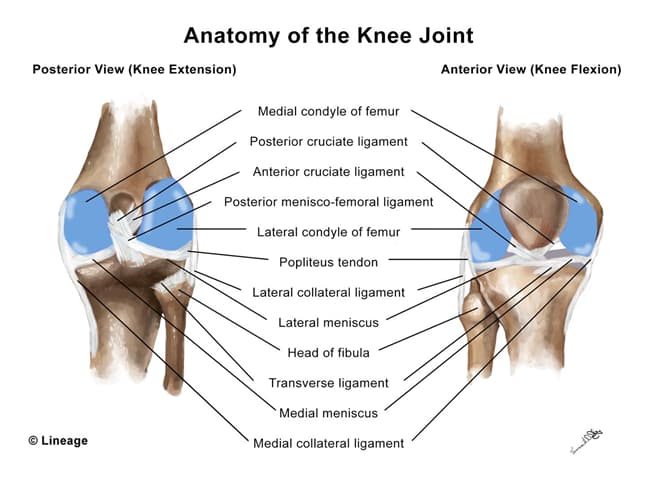Overview

Snapshot
- A 27-year-old woman presents to the emergency department for severe pain in the right knee. A few hours prior to presentation, an opposing soccer player strikes her leg from her right side while her foot was planted to the ground. Afterwards, she felt a “pop” sound that was followed by severe knee pain and swelling. After the swelling improved, she feels that her right knee is unstable. On physical exam, the patient has a positive Lachman test. The patient is asked to rest, place ice and compress the knee, and elevate the affected leg. Given her sport demands, a conversation is made on the necessity of surgical reconstruction of the anterior cruciate ligament.
Introduction
- Clinical definition
- injury in the form of tear or rupture affecting the anterior cruciate ligament (ACL) in the knee
- Epidemiology
- incidence
- non-contact ACL injuries are more common
- demographics
- more common in female athletes
- risk factors
- sports (e.g., football, soccer, skiers, and basketball)
- motor vehicle accidents
- incidence
- Pathoanatomy
- normal anatomy
- the ACL course
- originates in the posteromedial aspect of the lateral femoral condyle
- reaches the anteromedial aspect of the tibia
- the ACL course
- pathology
- contact mechanisms
- injury that causes hyperextension or valgus deformation of the knee
- e.g., football injury
- high-speed motor vehicle accident
- injury that causes hyperextension or valgus deformation of the knee
- non-contact mechanisms
- changing direction, pivoting, or landing that leads to rotation or valgus stress of the knee after sudden deceleration
- contact mechanisms
- normal anatomy
- Associated conditions
- Prognosis
- the majority of athletes are able to return to their sports activities with ACL reconstruction
Presentation
- Symptoms
- feeling a “pop” in the knee
- thereafter, there is acute swelling and pain
- unstable or “giving out” knee
- feeling a “pop” in the knee
- Physical exam
- hemarthrosis
Imaging
- Magnetic resonance imaging (MRI)
- indication
- an imaging modality that can confirm the diagnosis
- indication
- if reconstruction is a possibility or to identify concomitant knee pathology
Studies
- Making the diagnosis
- can be made based on typical clinical presentation alone
- can be confirmed by MRI or knee arthroscopy
Differential
- Meniscal tear
- Posterior collateral ligament (PCL) injury
- differentiating factor
- patients can have a positive posterior drawer test
- trauma is typically due to
- a motor vehicle accident leading to “dashboard injury”
- falling on a flexed knee while the foot is plantarflexed
- differentiating factor
- direct trauma to the proximal tibia
Treatment
- Conservative
- rest, ice, compression, and elevation (RICE) therapy
- indication
- management to reduce pain, edema, and hemarthrosis in the acute stage of the injury
- nonsteroidal anti-inflammatory drugs are typically added
- management to reduce pain, edema, and hemarthrosis in the acute stage of the injury
- indication
- rest, ice, compression, and elevation (RICE) therapy
- Operative
- surgical reconstruction
- indications
- performed in
- young and active patients with high demand sports or jobs
- significant knee instability
- performed in
- indications
- surgical reconstruction
- such as injuries affecting multiple knee structures (e.g., unhappy triad)
Complications
- Osteoarthritis
- Arthrosis
- Sports disability


